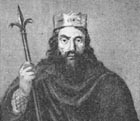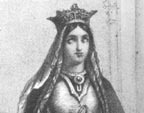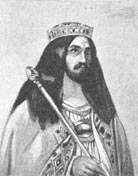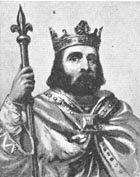 |
left: Clovis I (465 - 511),
King of Franks from 481 to 511
right: St. Clotilda (475 - 545),
married Clovis I in 493
|
 |
Origins
According to the seventh century chronicler Fredegar, the wife of semi-legendary King Clodio had an encounter with a legendary sea creature known as a Quinotaur. From this encounter came the ruler Merovich after whom the Merovingians were named. The son of Merovich was said to be Childeric, and his son was Clovis I (465 - 511).
The details of the lives and deeds as well as the actual relationship between Chlodio, Merovich and Childeric are shrouded in myth and legend. However these Salic chieftains were related, they were certainly part of the leading family of the Salian Franks. They were distinguished, like other Germanic aristocratic families by the fashion of allowing their hair (and sometimes beards as well) to grow long, and they became known as "the long haired kings".
Also known as "the Sorcerer Kings",
the Merovingians are said to have possessed supernatural powers including
the abilities to cure illness simply by touching the afflicted and to tame
wild animals as well as clairvoyant and telepathic powers.
|
|
Clovis I
Clovis I was the first important ruler
of the Merovingian Dynasty and is considered the founder of the French
State. He became Chieftain of the Salian Franks in 481. In
486, he defeated the last great Roman army in Gaul and went on to defeat
many minor princes, kings and tribal chieftains to form the first Frankish
Kingdom. Clovis I married in 493 to Clotilda (475 - 545), later St.
Clotilda, daughter of Childperic, King of the Burgundians.
 |
left: Clovis I (465 - 511),
King of Franks from 481 to 511
right: St. Clotilda (475 - 545),
married Clovis I in 493
|
 |
The Merovingian Kings
The Frankish Kingdom was split up among
Clovis' sons, and was temporarily united several times during the next
two centuries when a single heir survived; notably during the reigns of
Clothaire I, Clothaire II, Dagobert I and Clovis II
 |
 |
 |
 |
|
558 - 561 |
623 - 629 |
629 - 638 |
638 - 657 |
Germanic tribesmen living close to the North Sea tended to have fairly large timber houses supported by four rows of posts that divided the house into three rooms. The family lived in the centre room, while a smaller room on one side was used for storage and a larger room on the other side was used to house the animals whose body heat helped warm the living quarters. From this arrangement comes the story that "the people lived in the barn" or that "the cattle lived in the house."
 Further inland, people tended to inhabit dwellings that were supported
by upright posts but without interior supports. These dwellings varied
in size from 20 feet X 12 feet up to perhaps 25 feet square. Long,
narrow buildings about 12 feet X 25 feet housed the cattle while smaller
structures 12 feet square were used for storage. Some of these smaller
storage buildings were partially underground.
Further inland, people tended to inhabit dwellings that were supported
by upright posts but without interior supports. These dwellings varied
in size from 20 feet X 12 feet up to perhaps 25 feet square. Long,
narrow buildings about 12 feet X 25 feet housed the cattle while smaller
structures 12 feet square were used for storage. Some of these smaller
storage buildings were partially underground.
The main crops were barley, wheat, oats, peas and beans. Crop rotation was practiced, and fields were improved by adding limestone and manure. Depleted soil was abandoned and new land brought into use using the slash and burn technique. Simple scratch ploughs pulled by oxen were most common, and they didn't actually turn the soil. Grain was left attached to the hay and was roasted slightly to preserve it. Grain was separated from the hay as needed and ground using simple hand grindstones. Once ground, flour was used to prepare porridge and flat bread. Grain was also used to make beer.
Cattle were very important and were an indicator of wealth. Pigs, sheep, goats, horses, chickens and geese were also kept. Every portion of the animals was used either for food or for the production of clothing, shelter and utensils. Wild animals were hunted and killed for sport and to eliminate nuisance animals. Wild animals are thought to have made up less than 5% of the total animals used.
Iron was produced using small, crude but effective charcoal furnaces made of earth. These ovens held about a litre of ore, and only 200 grams of iron could be made at a time from the very best ore. This iron was worked into very high quality steel, far superior to the equipment of the Roman troops. However, the Germanic tribes were iron poor, and weapons such as long swords were rare.
Each individual household was dominated by the father who held authority over all the members. A number of households, sometimes as many as fifty, were grouped into a family clan-like organization. A number of clans formed a tribe which was sometimes overseen by a "king" who was really a tribal chieftain. The "king" was usually chosen from one family that was most closely identified with the ethnic, cultural and historical traditions of the tribe - that is, from a "royal family." Some tribes had several kings, one to preside over meetings, one for religious ceremonies and one for military command. Other tribes didn't have a king at all.
In order to survive and prosper, a tribe had become almost completely militarized; that is, the tribe had to become an army. This is what appears to have happened with the Salian Franks whose Merovingian Kings dominated the region from the fifth century onwards.
From the middle of the seventh century on, their
power declined and the real authority rested to an ever increasing extent
with the Mayors of the Palace. The king became a figurehead distinguished
by his beard, long hair, crown and throne. When King Theuderic IV
died in 737, he was not replaced. Charles Martel ruled instead as
Mayor of the Palace. Charles Martel died in 741 and was succeeded
by his sons Pépin the Short and Carloman. The brothers Pépin
and Carloman instituted another king, Childeric III in 743, largely to
ease the concern of other Frankish leaders about their growing power.
Carloman withdrew from politics in 747 and retired to the monastery of
Monte Casino. In 751, Childeric III also wisely decided to retire
to a monastery and Pépin the Short had himself proclaimed king in
November 751, thus officially ending the Merovingian Dynasty.
 |
left: Childeric III,
the last Merovingian King
right: Pépin I the Short,
the first Carolingian King
|
 |
Having displaced the Merovingians, it was in the interests of the Carolingian Kings to depict their predecessors as useless anachronisms. Hence, the earlier Merovingians were depicted as evil and brutal tyrants while later Merovingians were propagandized as lazy and simple incompetents. If a Merovingian could be deposed and sent to a monastery, and a new king consectrated in his place, so too could a Carolingian. Less than a century later, Louis the Pious was temporarily displaced; and by the tenth century, the Carolingians were replaced altogether by the Capetian Kings.
|
Click on The Merovingians for a more detailed descent of the Merovingian Kings. |
Please visit the Sewell Genealogy Site Map for other pages in this series.
| Click for
PDF index |
This summary was written in July 2006 by Robert Sewell using sources including the following:
World Book Millenium 2000 Deluxe Edition,
© 1999 World Book Inc., © IBM Corp.
Microsoft Encarta Encyclopædia 99,
© 1993-1998 Microsoft Corporation
Norman F. Cantor (ed.) The Encyclopædia of
the Middle Ages, New York, 1999
Barnes and Judson: History Atlas of Europe,
Macmillan Inc., New York, 1998
Berhard Grun, The Timetables of History,
New York, 1991
Patrick J. Geary: Before France and Germany,
Oxford University Press, 1988
George Andrews Moriarty: The
Plantagenet Ancestry of King Edward III and Queen Philippa,
Click to return to Cloderic the Parricide or to go to Pépin the Short